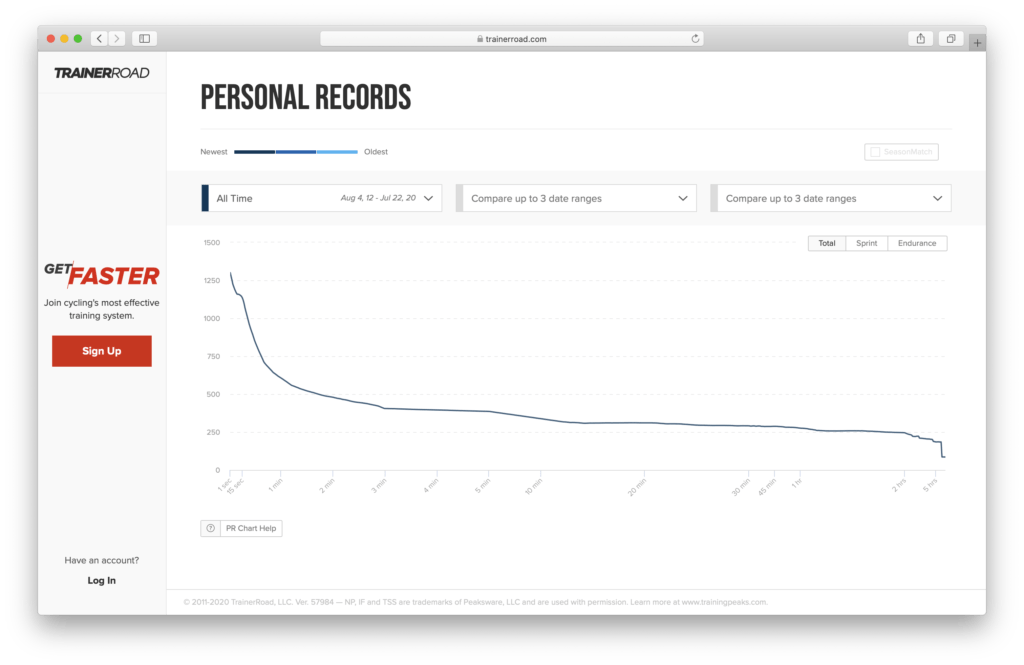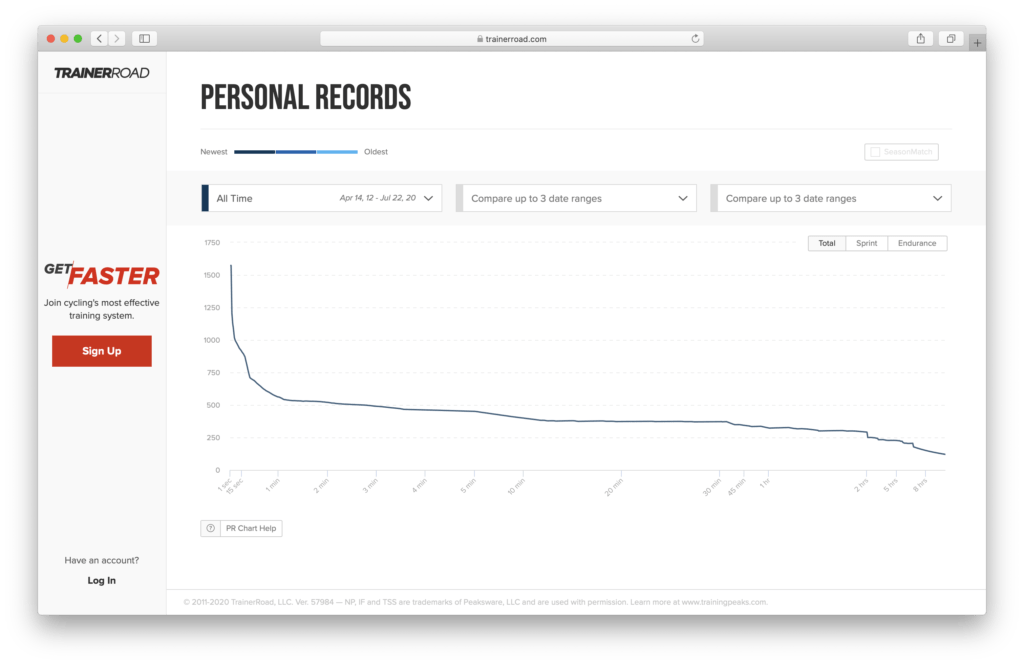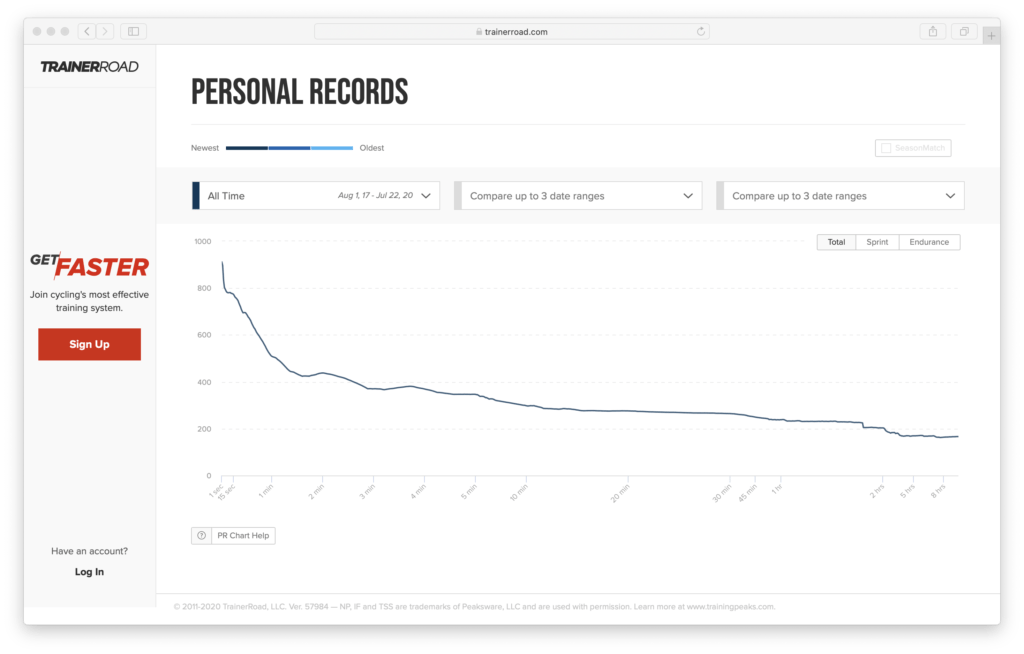How to Use Your Power Curve to Find Your Strengths and Weaknesses
Every cyclist has strengths and weaknesses. The good news is that specific types of fitness are highly trainable. So how do you use a cycling power curve to discover what you’re good at, what needs work, and what you can do with that information?
For more information on power curves and training check out Ask a Cycling Coach Ep 264.
What is a Cycling Power Curve?
A power curve is a graphical representation of the power you can generate over time. On the x-axis is time, and on the y-axis is watts. All power curves are unique, but all are generally higher on the left end and lower towards the right. This is because the amount of power we can produce declines over time.
Adaptive Training
Get the right workout, every time with training that adapts to you.
Check Out TrainerRoadA power curve is a valuable tool for analyzing your training, your strengths, and your weaknesses as a cyclist. The TrainerRoad power chart has three different levels so that you can drill into the details of your power. You can view your sprint power (1-30 seconds), endurance (30 seconds-hours), or the entire time frame. You can also set up individual seasons to track your training progress for specific periods of time.
How to Use a Power Curve
The value of a power curve is that it shows you the work you’ve done. Since it’s power plotted against time, it gives you a snapshot of your energy systems and a view of your strengths and weaknesses. Let’s take a look at some examples from a few of my colleagues. While there are several rider profile types, I’ve just used three. For simplicity, we are looking at their all-time power PR curves.
Short Power
I’m a typical short-power cyclist. I love sprints and quick, hard efforts, but struggle with long threshold work. You can see I can hold a decent amount of power for about 20 seconds, then my curve drops dramatically. After about ten minutes, the power levels off.

Sustained Power
Dominik’s power curve is an impressive display of endurance. He’s a long-distance triathlete. Notice how flat the power curve is from one minute to five hours. This shows his high level of fatigue resistance and the ability to hold near threshold power for long durations.

VO2 Max
Colin is a self-described “lackluster sprinter.” While his peak power output isn’t very high, his VO2 Max power is a strength. At two and four minutes on the curve, the power increases. After five minutes, the power drops off. As expected, Colin excels at short, punchy climbs.

Examine your power curve to discover where your abilities are. You can go a step further and create custom seasons to see how this has changed over time. Once you’ve got a handle on your strengths and weaknesses, you can decide if you want to change your power curve.
How Trainable is Your Power Curve?
Your cycling power curve is highly trainable. Regardless of your genetic disposition, you can target specific energy systems by training different muscle fiber types. You can target adaptations within your muscle fibers so that one fiber type is capable of more than one thing.
Muscle Fiber Types
Skeletal muscles are comprised of three different fibers. Type I fibers, often called slow-twitch, are powered by aerobic processes and responsible for your endurance. While Type I fibers don’t produce massive power, they fatigue slowly. There are two kinds of type II fibers; both are referred to as fast-twitch. Type IIa, are intermediate fibers. They can use both aerobic and anaerobic metabolism to create energy. Your training profoundly influences type IIa fibers towards aerobic or anaerobic metabolism. Type IIb fibers are anaerobically fueled and fatigue rapidly. They produce high power, albeit for short durations.
Each muscle fiber type is on a spectrum of power production. They can do all things to some degree. If you do a bunch of Zone 2 up to Sweet Spot, you’re going to get more aerobic adaptations, especially in type IIa fibers. An athlete who does more anaerobic work will carry more anaerobic adaptations into the intermediate muscle fibers.
Fueling Your Workouts
Planning nutrition for your workouts can also affect your power curve. High-intensity, anaerobic work requires sugar to fuel the muscles. That means that if you are looking to increase your peak power and sprint capacity, you’ll want to ensure you have enough carbs onboard.
Likewise, if you are using a low-carb diet or fasted rides, remember that your workout options will be limited. These two methods can help you target aerobic adaptations in the form of increased mitochondrial biogenesis and fat utilization. Riding in a low-carb state is going to metabolize amino acids from the muscle. Just remember to replenish with plenty of protein afterward.
Nutrition should center on chasing performance. Fuel the work in a way that will help you reach your goals. It’s always a good idea to make any changes to your nutrition slowly. That way, your body can adjust accordingly.
Don’t Limit Yourself
A power curve doesn’t define you as an athlete. It only shows the work you’ve done. Just because you’re good at one thing doesn’t mean you can’t be great at something else. Types of fitness are highly trainable. If you want to change your power curve, do so intentionally to fit your goals. What is a weakness now, can become a strength with the proper training. For more information on specific training zones, check out Cycling Power Zones: Training Zones Explained.
For more cycling training knowledge, listen to Ask a Cycling Coach — the only podcast dedicated to making you a faster cyclist. New episodes are released weekly.
Photo Credit: Nick Wilson
Model Credit: Calvin Smith
